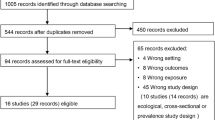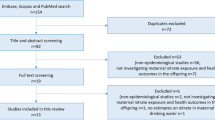Abstract
Birth weight may be influenced by environmental and socio-economic factors that could interact. The main objective of our research was to investigate whether area deprivation may modify the association between drinking water exposure to a mixture of atrazine metabolites and nitrates during the second trimester of pregnancy and prevalence of small for gestational age (SGA) neonates. We conducted a historic cohort study in Deux-Sèvres, France between 2005 and 2010, using birth records, population census and regularly performed drinking water withdrawals at community water systems. Exposure to an atrazine metabolite/nitrate mixture in drinking water was divided into six classes according to the presence or absence of atrazine metabolites and to the terciles of nitrate concentrations in each trimester of pregnancy. We used a logistic regression to model the association between SGA and mixture exposure at the second trimester while taking into account the area deprivation measured by the Townsend index as an effect modifier and controlling for the usual confounders. We included 10,784 woman–neonate couples. The risk of SGA when exposed to second tercile of nitrate without atrazine metabolites was significantly greater in women living in less deprived areas (OR = 2.99; 95 % CI (1.14, 7.89)), whereas it was not significant in moderately and more deprived areas. One of the arguments used to explain this result is the presence of competing risk factors in poorer districts.


Similar content being viewed by others
References
Albouy-Llaty M, Thiebaugeorges O, Goua V, Magnin G, Schweitzer M, Forhan A, Lelong N, Slama R, Charles MA, Kaminski M (2011) Influence of fetal and parental factors on intrauterine growth measurements: results of the EDEN mother-child cohort. Ultrasound Obstet Gynecol 38(6):673–680
Balazs C, Morello-Frosch R, Hubbard A, Ray I (2011) Social disparities in nitrate-contaminated drinking water in California’s San Joaquin Valley. Environ Health Perspect 119(9):1272–1278
Barker DJP (2004) The developmental origins of adult disease. J Am Coll Nutr 23(6 Suppl):588S–595S
Braveman PA, Cubbin C, Egerter S, Chideya S, Marchi KS, Metzler M, Posner S (2005) Socioeconomic status in health research: one size does not fit all. JAMA 294(22):2879–2888
Bukowski J, Somers G, Bryanton J (2001) Agricultural contamination of groundwater as a possible risk factor for growth restriction or prematurity. J Occup Environ Med 43(4):377–383
Bundred P, Manning D, Brewster B, Buchan I (2003) Social trends in singleton births and birth weight in Wirral residents, 1990–2001. Arch Dis Child Fetal Neonatal Ed 88(5):F421–F425
Chaix B, Chauvin P (2002) The contribution of multilevel models in contextual analysis in the field of social epidemiology: a review of literature. Rev Epidemiol Sante Publique 50(5):489–499 (in French)
Charafeddine R, Boden LI (2008) Does income inequality modify the association between air pollution and health? Environ Res 106(1):81–88
Chen L, Bell EM, Caton AR, Druschel CM, Lin S (2010) Residential mobility during pregnancy and the potential for ambient air pollution exposure misclassification. Environ Res 110(2):162–168
Chevrier C, Limon G, Monfort C, Rouget F, Garlantézec R, Petit C, Durand G, Cordier S (2011) Urinary biomarkers of prenatal atrazine exposure and adverse birth outcomes in the PELAGIE birth cohort. Environ Health Perspect 119(7):1034–1041
Christie SML, Fone DL (2003) Does car ownership reflect socio-economic disadvantage in rural areas? A cross-sectional geographical study in Wales, UK. Public Health 117(2):112–116
Collet M, Vilain A (2010) Les certificats de santé de l’enfant au 8ème jour (CS8). Validité 2006 et 2007. Document de travail 12. Série sources et méthodes. Direction de la Recherche, des Études, de L’évaluation et des Statistiques (DREES). http://www.rpfc.fr/espacepro/wp-content/pdf/seriesource-method12.pdf (in French). Accessed 10 Jan 2013
Culhane JF, Elo IT (2005) Neighborhood context and reproductive health. Am J Obstet Gynecol 192(5 Suppl):S22–S29
Fell DB, Dodds L, King WD (2004) Residential mobility during pregnancy. Paediatr Perinat Epidemiol 18(6):408–414
Figueiras A, Domenech-Massons JM, Cadarso C (1998) Regression models: calculating the confidence interval of effects in the presence of interactions. Stat Med 17(18):2099–2105
Forssén UM, Herring AH, Savitz DA, Nieuwenhuijsen MJ, Murphy PA, Singer PC, Wright JM (2007) Predictors of use and consumption of public drinking water among pregnant women. J Expo Sci Environ Epidemiol 17(2):159–169
Freire C, Amaya E, Fernández MF, González-Galarzo MC, Ramos R, Molina-Molina JM, Arrebola JP, Olea N (2011) Relationship between occupational social class and exposure to organochlorine pesticides during pregnancy. Chemosphere 83(6):831–838
Gee GC, Payne-Sturges DC (2004) Environmental health disparities: a framework integrating psychosocial and environmental concepts. Environ Health Perspect 112(17):1645–1653
Généreux M, Auger N, Goneau M, Daniel M (2008) Neighbourhood socioeconomic status, maternal education and adverse birth outcomes among mothers living near highways. J Epidemiol Community Health 62(8):695–700
Gouveia N, Fletcher T (2000) Time series analysis of air pollution and mortality: effects by cause, age and socioeconomic status. J Epidemiol Community Health 54(10):750–755
Havard S, Deguen S, Zmirou-Navier D, Schillinger C, Bard D (2009) Traffic-related air pollution and socioeconomic status: a spatial autocorrelation study to assess environmental equity on a small-area scale. Epidemiology 20(2):223–230
Hodgson S, Shirley M, Bythell M, Rankin J (2009) Residential mobility during pregnancy in the north of England. BMC Pregnancy Childbirth 9:52
INSEE (1999). Correspondence addresses/IRIS 2000–1999. Centre Maurice Halbwachs (CMH), Paris.
Kramer MS (1987) Determinants of low birth weight: methodological assessment and meta-analysis. Bull World Health Organ 65(5):663–737
Krieger N, Chen JT, Waterman PD, Soobader MJ, Subramanian SV, Carson R (2003) Choosing area based socioeconomic measures to monitor social inequalities in low birth weight and childhood lead poisoning: The Public Health Disparities Geocoding Project (US). J Epidemiol Community Health 57(3):186–199
Mamelle N, Munoz F, Grandjean H (1996) Fetal growth from the AUDIPOG study. I. Establishment of reference curves. J Gynecol Obstet Biol Reprod 25(1):61–70 (in French)
McIntire DD, Bloom SL, Casey BM, Leveno KJ (1999) Birth weight in relation to morbidity and mortality among newborn infants. N Engl J Med 340(16):1234–1238
Menard C, Girard D, Léon C, Beck F, Lamoureux P (2008) Baromètre santé environnement 2007. Saint-Denis: INEPS, coll. Baromètre Santé: 420p. http://inpes.fr/Barometres/BSE2007/pdf/eau_robinet.pdf (in French). Accessed 10 Jan 2013
Metcalfe A, Lail P, Ghali WA, Sauve RS (2011) The association between neighbourhoods and adverse birth outcomes: a systematic review and meta-analysis of multi-level studies. Paediatr Perinat Epidemiol 25(3):236–245
Migeot V, Albouy-Llaty M, Carles C, Limousi F, Strezlec S, Dupuis A, Rabouan S (2013) Drinking-water exposure to a mixture of nitrate and low-dose atrazine metabolites and small-for-gestational age (SGA) babies: a historic cohort study. Environ Res 122:58–64
Miranda ML, Maxson P, Edwards S (2009) Environmental contributions to disparities in pregnancy outcomes. Epidemiol Rev 31:67–83
Ochoa-Acuña H, Frankenberger J, Hahn L, Carbajo C (2009) Drinking water herbicide exposure in Indiana and prevalence of small-for-gestational-age and preterm delivery. Environ Health Perspect 117(10):1619–1624
Ponce NA, Hoggatt KJ, Wilhelm M, Ritz B (2005) Preterm birth: the interaction of traffic-related air pollution with economic hardship in Los Angeles neighborhoods. Am J Epidemiol 162(2):140–148
Pornet C, Delpierre C, Dejardin O, Grosclaude P, Launay L, Guittet L, Lang T, Launoy G (2012) Construction of an adaptable European transnational ecological deprivation index: the French version. J Epidemiol Community Health 66(11):982–989
Registry (2003) Toxicological profile for atrazine. http://www.atsdr.cdc.gov/toxprofiles/tp153.pdf (Accessed 26 Feb 2013)
Ribet C, Melchior M, Lang T, Zins M, Goldberg M, Leclerc A (2007) Characterisation and measurement of social position in epidemiologic studies. Rev Epidemiol Sante Publique 55(4):285–295 (in French)
Sheehan DM, Willingham E, Gaylor D, Bergeron JM, Crews D (1999) No threshold dose for estradiol-induced sex reversal of turtle embryos: how little is too much? Environ Health Perspect 107(2):155–159
Silins I, Högberg J (2011) Combined toxic exposures and human health: biomarkers of exposure and effect. Int J Environ Res Public Health 8(3):629–647
Spencer N, Bambang S, Logan S, Gill L (1999) Socioeconomic status and birth weight: comparison of an area-based measure with the Registrar General’s social class. J Epidemiol Community Health 53(8):495–498
Timmermans S, Bonsel GJ, Steegers-Theunissen RPM, Mackenbach JP, Steyerberg EW, Raat H, Verbrugh HA et al (2011) Individual accumulation of heterogeneous risks explains perinatal inequalities within deprived neighbourhoods. Eur J Epidemiol 26(2):165–180
Townsend P, Phillimore P, Beattie A (1988) Health and deprivation: inequality and the North. Croom Helm, London
Vrijheid M, Martinez D, Aguilera I, Ballester F, Basterrechea M, Esplugues A, Guxens M et al (2010) Socioeconomic status and exposure to multiple environmental pollutants during pregnancy: evidence for environmental inequity? J Epidemiol Community Health 66(2):106–113
Yi O, Kim H, Ha E (2010) Does area level socioeconomic status modify the effects of PM10 on preterm delivery? Environ Res 110(1):55–61
Zeka A, Melly SJ, Schwartz J (2008) The effects of socioeconomic status and indices of physical environment on reduced birth weight and preterm births in Eastern Massachusetts. Environ Health 7:60
Zender R, Bachand AM, Reif JS (2001) Exposure to tap water during pregnancy. J Expo Anal Environ Epidemiol 11(3):224–230
Acknowledgments
We wish to thank the Agence Régionale de Santé and particularly Dr. Paul Lechuga and Dr. Michel Guitton for having enabled this study to be carried out by agreeing to share their data on drinking water nitrate and pesticide measurements. We wish to thank the Conseil Général des Deux-Sèvres, Service de Protection Maternelle et Infantile and particularly Dr. Sylvie Strezlec sharing their birth records data. We also wish to thank the Centre Maurice Halbwach and particularly Alexandre Kysch for providing the correlation map between addresses and IRIS. Finally, we wish to thank Jeffrey Arsham for his English language revision.
Author information
Authors and Affiliations
Corresponding author
Additional information
Responsible editor: Philippe Garrigues
Electronic supplementary material
Below is the link to the electronic supplementary material.
ESM 1
(DOCX 35 kb)
Rights and permissions
About this article
Cite this article
Limousi, F., Albouy-Llaty, M., Carles, C. et al. Does area deprivation modify the association between exposure to a nitrate and low-dose atrazine metabolite mixture in drinking water and small for gestational age? A historic cohort study. Environ Sci Pollut Res 21, 4964–4973 (2014). https://doi.org/10.1007/s11356-013-1893-5
Received:
Accepted:
Published:
Issue Date:
DOI: https://doi.org/10.1007/s11356-013-1893-5




